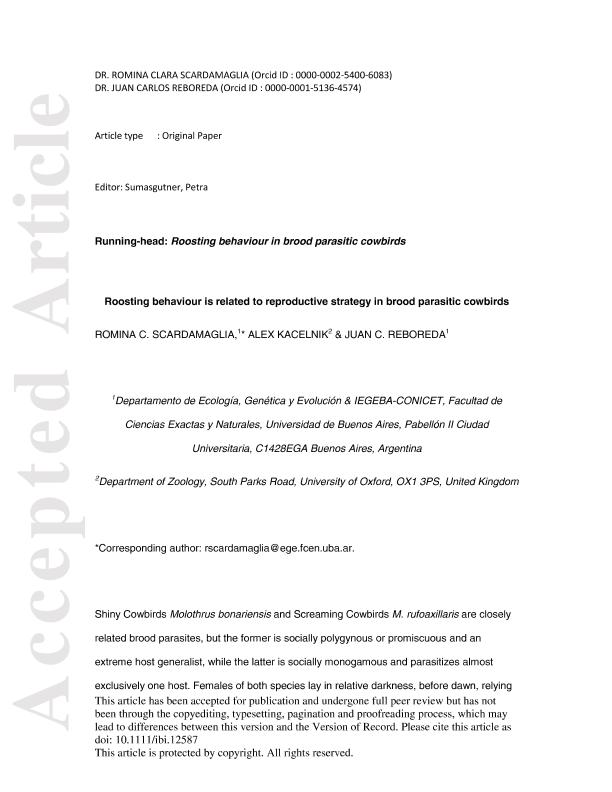Mostrar el registro sencillo del ítem
dc.contributor.author
Scardamaglia, Romina Clara

dc.contributor.author
Kacelnik, Alex

dc.contributor.author
Reboreda, Juan Carlos

dc.date.available
2020-02-03T20:19:57Z
dc.date.issued
2018-10
dc.identifier.citation
Scardamaglia, Romina Clara; Kacelnik, Alex; Reboreda, Juan Carlos; Roosting behaviour is related to reproductive strategy in brood parasitic cowbirds; Wiley Blackwell Publishing, Inc; Ibis; 160; 4; 10-2018; 779-789
dc.identifier.issn
0019-1019
dc.identifier.uri
http://hdl.handle.net/11336/96594
dc.description.abstract
Shiny Cowbirds Molothrus bonariensis and Screaming Cowbirds Molothrus rufoaxillaris are closely related brood parasites but the former is socially polygynous or promiscuous and an extreme host generalist, whereas the latter is socially monogamous and parasitizes almost exclusively one host. Females of both species lay in relative darkness, before dawn, relying for host nest location on previous days’ prospecting activity, or possibly on following better-informed roost associates. We studied the temporal and spatial patterns of roosting behaviour in these species to test the hypothesis that roosting behaviour of cowbirds is related to their breeding strategy (brood parasitism) and reflects differences in strategies between species. We recorded fidelity to a roost, location fidelity within a roost, inter-individual spatial associations and timing of roost departures and parasitic events, using tagged individuals. Female Shiny Cowbirds and both sexes of Screaming Cowbirds showed marked fidelity in roosting location, and roost departures occurred both during and after the known time window for parasitism, with earlier departures probably corresponding to laying days. Screaming Cowbird females and males that were trapped together and showed high levels of association during the day, also showed high levels of association in the roost. We describe the spatial and temporal patterns of a relatively poorly known aspect of avian ecology in general and the behaviour of brood parasites in particular.
dc.format
application/pdf
dc.language.iso
eng
dc.publisher
Wiley Blackwell Publishing, Inc

dc.rights
info:eu-repo/semantics/openAccess
dc.rights.uri
https://creativecommons.org/licenses/by-nc-sa/2.5/ar/
dc.subject
BIRD ASSEMBLAGE
dc.subject
MOLOTHRUS
dc.subject
RADIO-TRACKING
dc.subject
SITE FIDELITY
dc.subject
SPACE USE
dc.subject.classification
Zoología, Ornitología, Entomología, Etología

dc.subject.classification
Ciencias Biológicas

dc.subject.classification
CIENCIAS NATURALES Y EXACTAS

dc.title
Roosting behaviour is related to reproductive strategy in brood parasitic cowbirds
dc.type
info:eu-repo/semantics/article
dc.type
info:ar-repo/semantics/artículo
dc.type
info:eu-repo/semantics/publishedVersion
dc.date.updated
2019-10-09T20:43:58Z
dc.journal.volume
160
dc.journal.number
4
dc.journal.pagination
779-789
dc.journal.pais
Reino Unido

dc.journal.ciudad
Londres
dc.description.fil
Fil: Scardamaglia, Romina Clara. Consejo Nacional de Investigaciones Científicas y Técnicas. Oficina de Coordinación Administrativa Ciudad Universitaria. Instituto de Ecología, Genética y Evolución de Buenos Aires. Universidad de Buenos Aires. Facultad de Ciencias Exactas y Naturales. Instituto de Ecología, Genética y Evolución de Buenos Aires; Argentina
dc.description.fil
Fil: Kacelnik, Alex. University of Oxford; Reino Unido
dc.description.fil
Fil: Reboreda, Juan Carlos. Consejo Nacional de Investigaciones Científicas y Técnicas. Oficina de Coordinación Administrativa Ciudad Universitaria. Instituto de Ecología, Genética y Evolución de Buenos Aires. Universidad de Buenos Aires. Facultad de Ciencias Exactas y Naturales. Instituto de Ecología, Genética y Evolución de Buenos Aires; Argentina
dc.journal.title
Ibis

dc.relation.alternativeid
info:eu-repo/semantics/altIdentifier/doi/https://doi.org/10.1111/ibi.12587
dc.relation.alternativeid
info:eu-repo/semantics/altIdentifier/url/https://onlinelibrary.wiley.com/doi/abs/10.1111/ibi.12587
Archivos asociados
